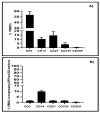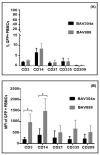Bovine Adenovirus-3 Tropism for Bovine Leukocyte Sub-Populations
- PMID: 33322850
- PMCID: PMC7763465
- DOI: 10.3390/v12121431
Bovine Adenovirus-3 Tropism for Bovine Leukocyte Sub-Populations
Abstract
A number of characteristics including lack of virulence and the ability to grow to high titers, have made bovine adenovirus-3 (BAdV-3) a vector of choice for further development as a vaccine-delivery vehicle for cattle. Despite the importance of blood leukocytes, including dendritic cells (DC), in the induction of protective immune responses, little is known about the interaction between BAdV-3 and bovine blood leukocytes. Here, we demonstrate that compared to other leukocytes, bovine blood monocytes and neutrophils are significantly transduced by BAdV404a (BAdV-3, expressing enhanced yellow green fluorescent protein [EYFP]) at a MOI of 1-5 without a significant difference in the mean fluorescence of EYFP expression. Moreover, though expression of some BAdV-3-specific proteins was observed, no progeny virions were detected in the transduced monocytes or neutrophils. Interestingly, addition of the "RGD" motif at the C-terminus of BAdV-3 minor capsid protein pIX (BAV888) enhanced the ability of the virus to enter the monocytes without altering the tropism of BAdV-3. The increased uptake of BAV888 by monocytes was associated with a significant increase in viral genome copies and the abundance of EYFP and BAdV-3 19K transcripts compared to BAdV404a-transduced monocytes. Our results suggest that BAdV-3 efficiently transduces monocytes and neutrophils in the absence of viral replication. Moreover, RGD-modified capsid significantly increases vector uptake without affecting the initial interaction with monocytes.
Keywords: EYFP; RGD motif; bovine adenovirus-3; chimeric pIX; leukocytes; tropism.
Conflict of interest statement
The authors declare no conflict of interest. Moreover, the funders had no role in the design of the study; in the collection, analyses, or interpretation of data; in the writing of the manuscript, or in the decision to publish the results.
Figures







Similar articles
-
Deletion of pV affects integrity of capsid causing defect in the infectivity of bovine adenovirus-3.J Gen Virol. 2016 Oct;97(10):2657-2667. doi: 10.1099/jgv.0.000570. Epub 2016 Aug 11. J Gen Virol. 2016. PMID: 27521148
-
Regions of bovine adenovirus-3 IVa2 involved in nuclear/nucleolar localization and interaction with pV.Virology. 2020 Jul;546:25-37. doi: 10.1016/j.virol.2020.04.006. Epub 2020 Apr 11. Virology. 2020. PMID: 32452415
-
Proteolytic Cleavage of Bovine Adenovirus 3-Encoded pVIII.J Virol. 2017 Apr 28;91(10):e00211-17. doi: 10.1128/JVI.00211-17. Print 2017 May 15. J Virol. 2017. PMID: 28298598 Free PMC article.
-
Murine adenoviruses: tools for studying adenovirus pathogenesis in a natural host.FEBS Lett. 2019 Dec;593(24):3649-3659. doi: 10.1002/1873-3468.13699. Epub 2019 Dec 6. FEBS Lett. 2019. PMID: 31777948 Free PMC article. Review.
-
Tropism and transduction of oncolytic adenovirus 5 vectors in cancer therapy: Focus on fiber chimerism and mosaicism, hexon and pIX.Virus Res. 2018 Sep 15;257:40-51. doi: 10.1016/j.virusres.2018.08.012. Epub 2018 Aug 17. Virus Res. 2018. PMID: 30125593 Review.
References
Publication types
MeSH terms
Substances
Supplementary concepts
LinkOut - more resources
Full Text Sources

